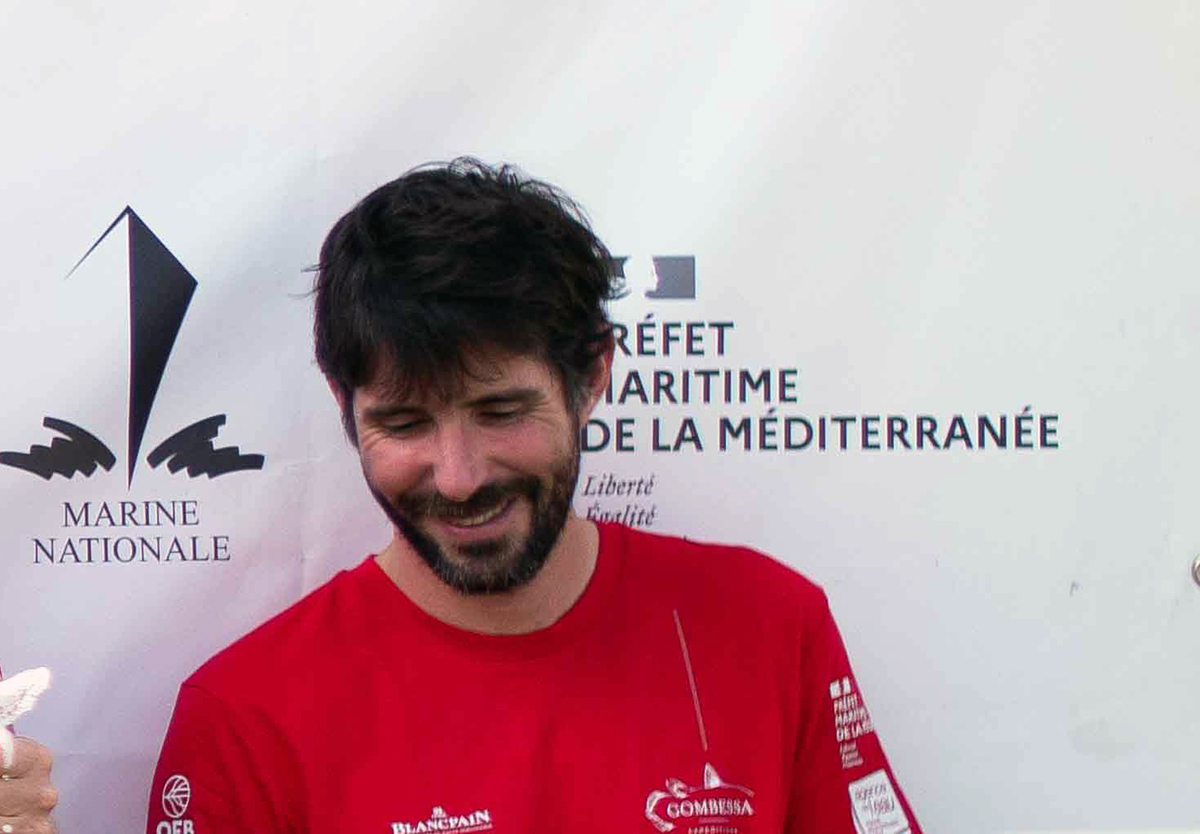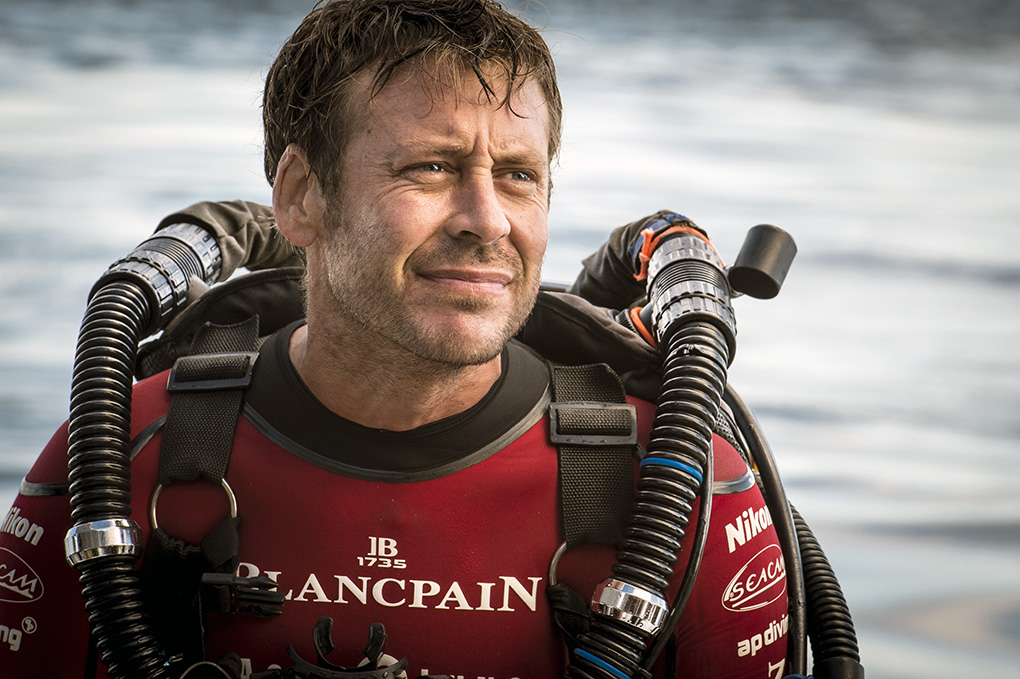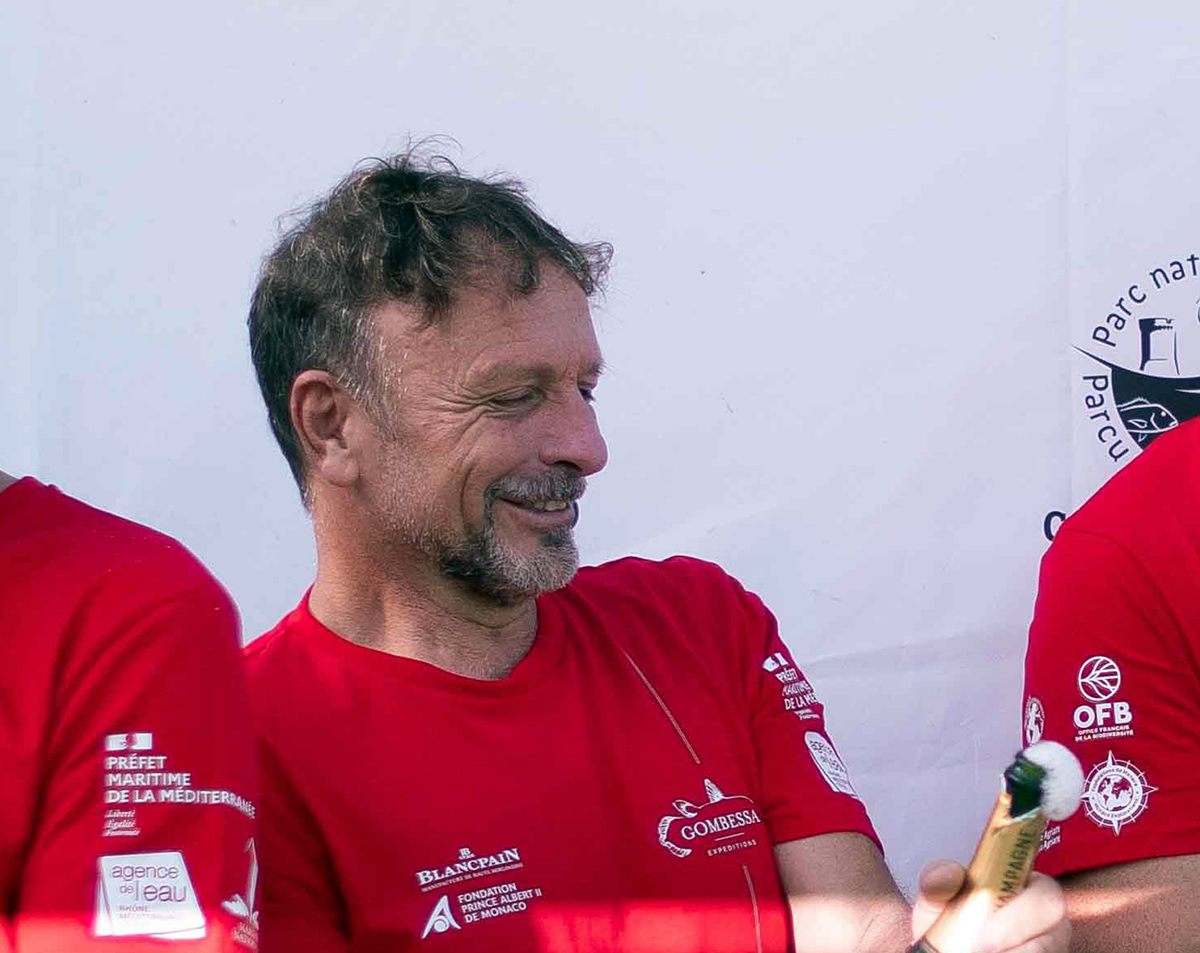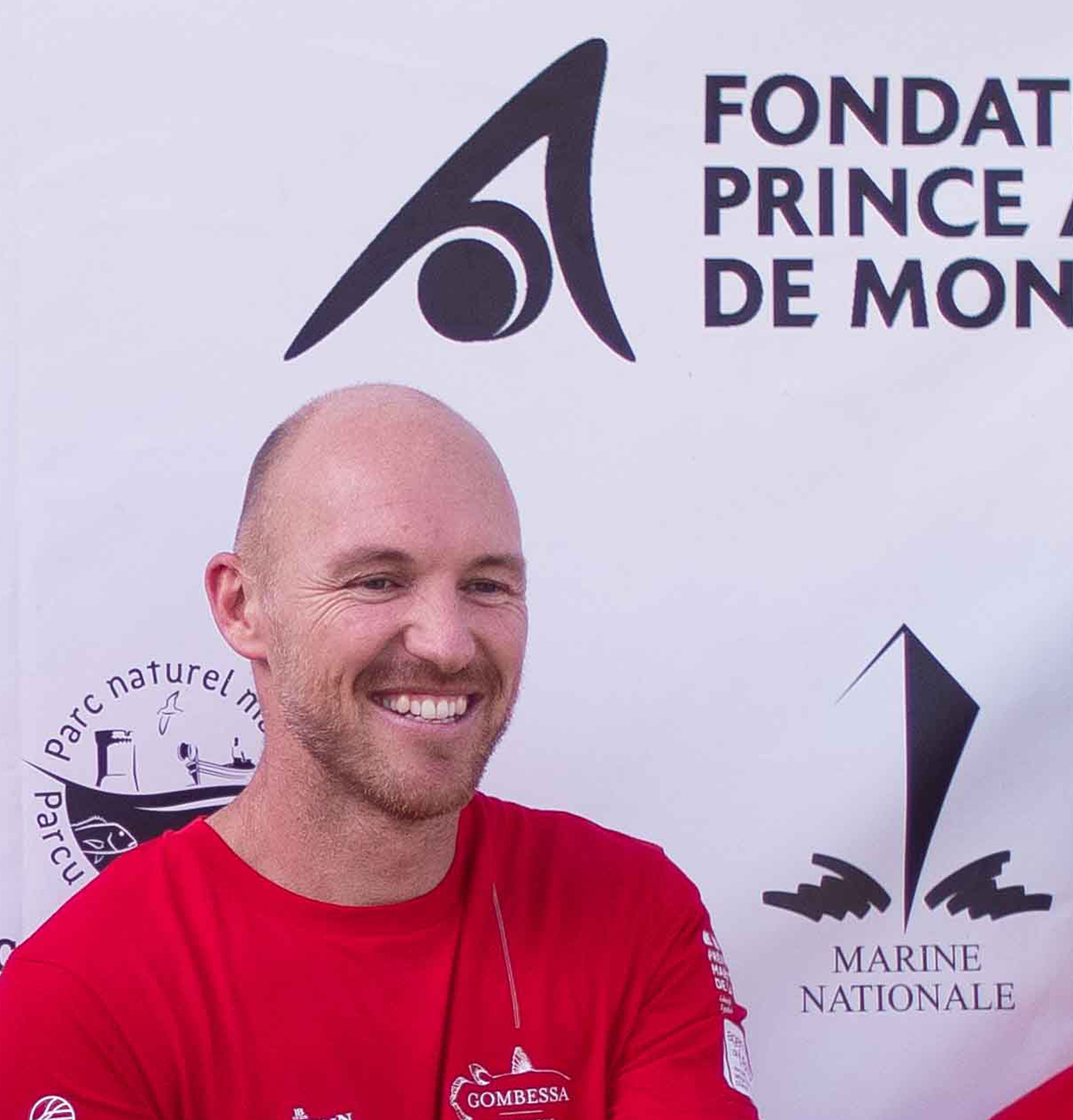23 July 2021
Gombessa 6 Cap Corse. Back to the surface in Monaco
Return to the surface in Monaco on 20 July 2021
After a 20-day expedition to try and unravel the mystery of the corallogenic rings off Cap Corse, the Gombessa 6 expedition flotilla, composed of the support and assistance vessel Pionnier, the catamaran Victoria IV and the barge from the French National Institute of Professional Diving (INPP), arrived in the port of Monaco late on Monday 19 July. The expedition ending in Monaco acknowledged a long-standing collaboration with the Principality. The Prince Albert II of Monaco Foundation and Monaco Explorations were indeed among the main partners of the last two Gombessa 5 and 6 expeditions.
The four aquanauts: Laurent Ballesta, Antonin Guilbert, Thibaut Rauby and Roberto Rinaldi exited the “bathyal station” the next day, Tuesday 20 July at 6 pm, after completing their decompression cycle.
The INPP barge in the port of Monaco for the return of the Gombessa 6 expedition from Cap Corse. 20 July 2021©Didier Théron. Monaco Explorations
The Gombessa 6 flotilla in view of the Principality of Monaco. 19 July 2021©Didier Théron. Explorations of Monaco
© Didier Théron. Monaco Explorations
The Pioneer in the port of Monaco. 20 July 2021 © Didier Théron. Monaco Explorations
Gombessa 6 expedition. View of the bathyal station on the INPP barge. In the background, the Pioneer. 20 July 2021© Frédéric Pacorel. Oceanographic Institute
©Didier Théron. Monaco Explorations
The INPP barge in the port of Monaco for the return of the Gombessa 6 expedition from Cap Corse. 20 July 2021©Didier Théron. Monaco Explorations
The Gombessa 6 flotilla in view of the Principality of Monaco. 19 July 2021©Didier Théron. Explorations of Monaco
© Didier Théron. Monaco Explorations
The Pioneer in the port of Monaco. 20 July 2021 © Didier Théron. Monaco Explorations
Gombessa 6 expedition. View of the bathyal station on the INPP barge. In the background, the Pioneer. 20 July 2021© Frédéric Pacorel. Oceanographic Institute
©Didier Théron. Monaco Explorations
The INPP barge in the port of Monaco for the return of the Gombessa 6 expedition from Cap Corse. 20 July 2021©Didier Théron. Monaco Explorations
The Gombessa 6 flotilla in view of the Principality of Monaco. 19 July 2021©Didier Théron. Explorations of Monaco
© Didier Théron. Monaco Explorations
The Pioneer in the port of Monaco. 20 July 2021 © Didier Théron. Monaco Explorations
Gombessa 6 expedition. View of the bathyal station on the INPP barge. In the background, the Pioneer. 20 July 2021© Frédéric Pacorel. Oceanographic Institute
©Didier Théron. Monaco Explorations
The four deep-sea explorers were welcomed on their way out by official representatives of the Principality of Monaco © Frédéric Pacorel. Oceanographic Institute
The four deep-sea explorers were welcomed on their way out by official representatives of the Principality of Monaco © Frédéric Pacorel. Oceanographic Institute
Laurent Ballesta leaves the bathyal station. Monaco, 20 July 2021, 6 pm © Jordi Chias. Gombessa Expeditions
The four aquanauts of Gombessa 6 at the top of the bathyal station just after their exit. In the background: Mount Agel. Monaco, 20 July 2021© Jordi Chias. Gombessa Expeditions
The four deep-sea explorers were welcomed on their way out by official representatives of the Principality of Monaco © Frédéric Pacorel. Oceanographic Institute
The four deep-sea explorers were welcomed on their way out by official representatives of the Principality of Monaco © Frédéric Pacorel. Oceanographic Institute
Laurent Ballesta leaves the bathyal station. Monaco, 20 July 2021, 6 pm © Jordi Chias. Gombessa Expeditions
The four aquanauts of Gombessa 6 at the top of the bathyal station just after their exit. In the background: Mount Agel. Monaco, 20 July 2021© Jordi Chias. Gombessa Expeditions
The four deep-sea explorers were welcomed on their way out by official representatives of the Principality of Monaco © Frédéric Pacorel. Oceanographic Institute
The four deep-sea explorers were welcomed on their way out by official representatives of the Principality of Monaco © Frédéric Pacorel. Oceanographic Institute
Laurent Ballesta leaves the bathyal station. Monaco, 20 July 2021, 6 pm © Jordi Chias. Gombessa Expeditions
The four aquanauts of Gombessa 6 at the top of the bathyal station just after their exit. In the background: Mount Agel. Monaco, 20 July 2021© Jordi Chias. Gombessa Expeditions
The aquanauts' exit
The four deep-sea explorers were welcomed on their exit by H.E. Mr. Pierre Dartout, Minister of State of the Principality, H.E. Mr. Bernard Fautrier, Special Advisor to H.S.H. the Sovereign Prince in charge of environmental issues, Mr. Olivier Wenden, Vice-President of the Prince Albert II of Monaco Foundation, Mr. Robert Calcagno, Chief Executive Officer of Monaco Explorations and Mr. Gilles Bessero, Chief Operation Officer of Monaco Explorations.
First impressions
During the press conference held shortly before exiting the ‘bathyal station’, the four aquanauts gave their first impressions. The Gombessa 6 expedition was successfully completed in terms of scientific operations and image recording, despite the capricious weather.
Press conference live from the bathyal station. 20 July 2021, 5 pm, Monaco© Didier Théron. Monaco Explorations
What was exceptional was to discover places that we were not used to. Before the expedition began, I was afraid that spending 20 days around a sandy bottom would soon become tiresome. But we discovered an incredible biodiversity. It was a very good surprise.

Our first satisfaction, we succeeded. We were able to core rocks sometimes more than a metre deep in the heart of the rings. It was a complex scientific manipulation, which we could not test before, but it worked... First of all, we will have to analyse all our scientific research, and then we bring back a lot of images that will enable us to make a film, a book and to give lectures. We have approached new horizons that we had not imagined, and this gives us the desire to go further. The objectives have been achieved and it's wonderful.

Everything went well, there was no anxiety, it's always the last few minutes that seem endless.

We plunged onto a plain with expanses as far as the eye can see, which amazed us, and saw an incredible diversity.

What was exceptional was to discover places that we were not used to. Before the expedition began, I was afraid that spending 20 days around a sandy bottom would soon become tiresome. But we discovered an incredible biodiversity. It was a very good surprise.

Our first satisfaction, we succeeded. We were able to core rocks sometimes more than a metre deep in the heart of the rings. It was a complex scientific manipulation, which we could not test before, but it worked... First of all, we will have to analyse all our scientific research, and then we bring back a lot of images that will enable us to make a film, a book and to give lectures. We have approached new horizons that we had not imagined, and this gives us the desire to go further. The objectives have been achieved and it's wonderful.

A windy weather
Twelve deep dives at depths between 115 and 140 metres in 16 days: an intense rhythm for the four aquanauts, despite the often-violent winds to the north-east of Cap Corse, which the Gombessa 6 flotilla had to face. These difficult sea conditions made the handling of the diving turret particularly delicate, as it was lowered and raised on the barge for each dive. A remarkable technical achievement.
The aftermath of the mission
All the scientific protocols planned during the mission, set up with 35 French and foreign scientists, have been carried out: coring of two central corallogenic ring cores, installation and recovery of an acoustic Doppler current meter and hydrophones, 3D reconstruction (by photogrammetry) of 4 rings, collection of water and sediment samples, detection of unknown species, recording of images, etc. A first series of results will be presented in September. DNA samples and 3D modelling will soon shed light on the origin of the corallogenic rings, their functioning, and their age.
